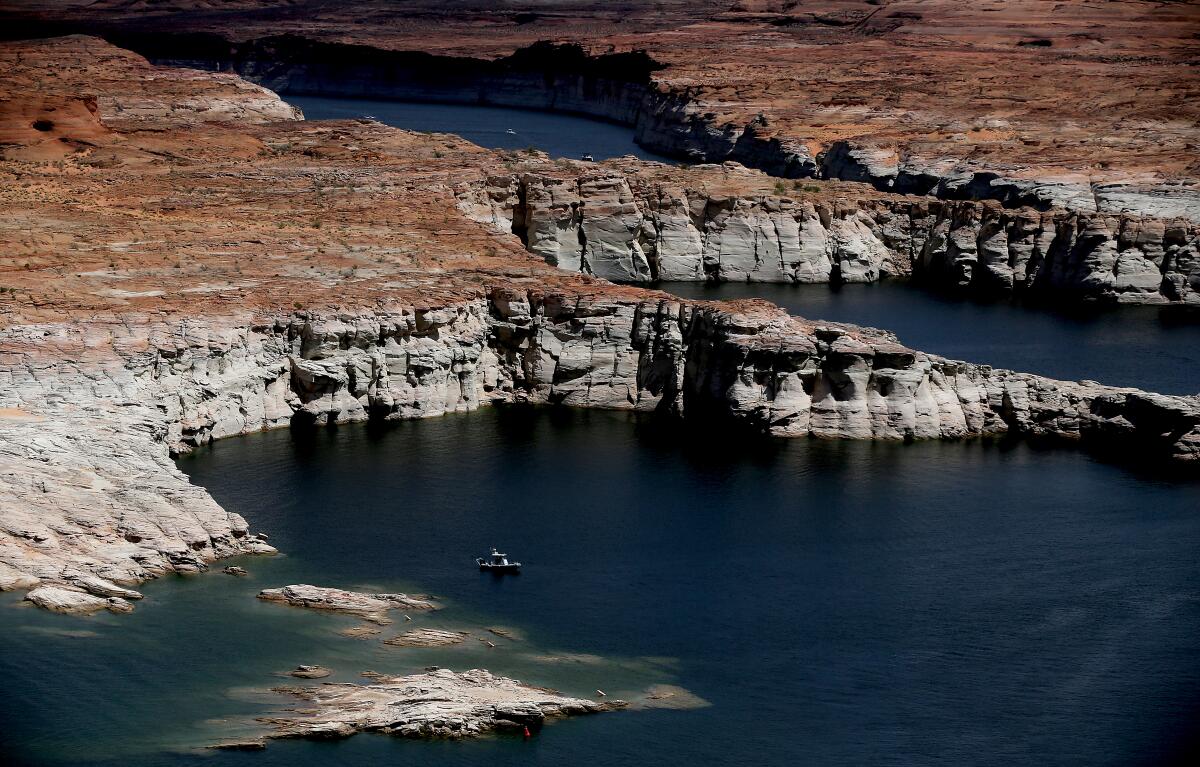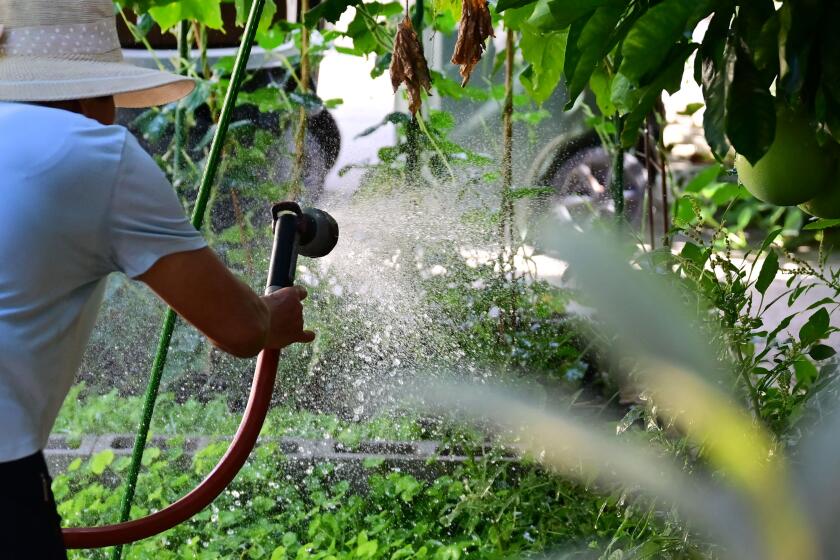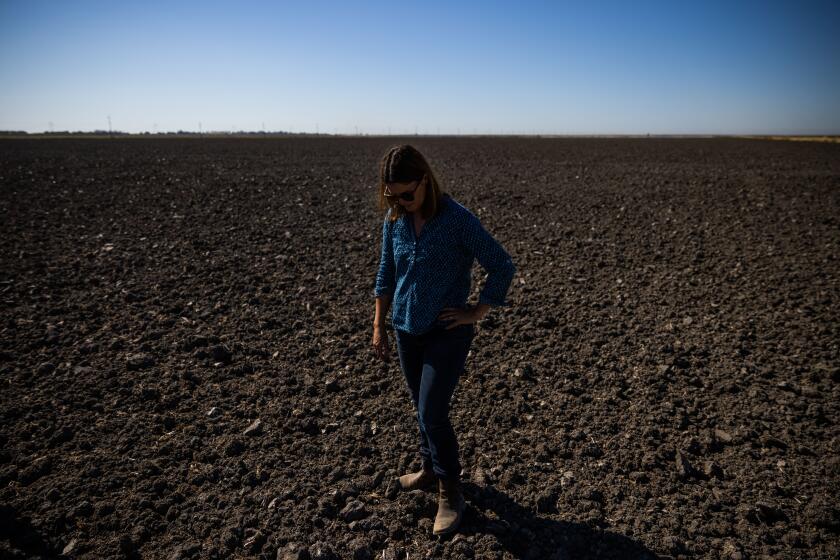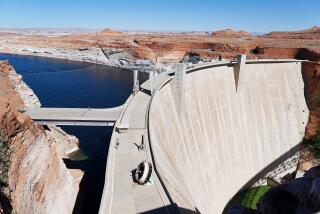Federal officials say urgent action needed to protect shrinking Colorado River reservoirs

LAS VEGAS — With Colorado River reservoirs nearing dangerously low levels, the federal government has given basin states a Jan. 31 deadline to negotiate major water cuts and stave off a possible collapse in supplies.
Speaking at a conference in Las Vegas, federal officials told water managers from the seven states that rely on the river that they will weigh immediate options next year to protect water levels in depleted reservoirs, and that the region must be prepared for the river to permanently yield less water because of climate change.
“The hotter, drier conditions that we face today are not temporary. Climate change is here today and has made it likely that we will continue to see conditions like this, if not worse, in the future,” said Reclamation Commissioner Camille Calimlim Touton.
“The basin is seeing its worst drought in 1,200 years, and there is no relief in sight. And perhaps this is what it will be in the future,” Touton said.
Colorado River reservoirs have fallen to alarming levels, prompting growing calls for urgent action to cut water use in seven states.
Lake Mead and Lake Powell, the nation’s two largest reservoirs, are now nearly three-fourths empty, and water levels are set to continue dropping. The latest government estimates show there is a risk that Lake Mead could reach “dead pool” levels in 2025, at which point the river would no longer flow past Hoover Dam, cutting off water for California, Arizona and Mexico.
That grim scenario has given urgency to the search for solutions, as officials from states, water agencies, tribes and the federal government consider options for water cutbacks on a scale never seen before.
Speaking at the conference Friday, Touton said: “I can feel the anxiety, the uncertainty in this room, and in the basin, as we look at the river and the hydrology that we face.”
Touton noted that an agreement a century ago, the 1922 Colorado River Compact, divided the water among the states, and she said there is now an opportunity to build a “new collaborative framework.”
“We are acting now to protect the Colorado River system and the future of America’s hardest-working river,” she said.
The federal government has begun the process of revising the rules for dealing with shortages. Federal dam managers also have started reducing the amount of water they release from Glen Canyon Dam over the next five months to boost the level of Lake Powell until the spring runoff arrives. And they have warned they may need to further cut the amount of water they release from the dam, which would shrink the flow downstream and accelerate the decline of Lake Mead.
The Bureau of Reclamation has begun an expedited environmental review process that will include alternatives for revising the current rules for managing the river in a shortage. As part of the process, the federal government has asked the region’s water managers to develop a consensus agreement to meet a goal of reducing water use by 2 million to 4 million acre-feet per year, a decrease of roughly 15% to 30%.
“The challenge that we have in this system is it was built in the last century, and so the way that we operate for this hydrology doesn’t work,” Touton said. “The hydrology is really dictating what we need.”
Another alternative would be for the Interior secretary to exercise federal authority to change reservoir operations, which could be done in addition to any regional water-saving agreement if the reductions turn out to be insufficient.
“We hope a consensus alternative emerges from the basin before the end of January,” Touton said. “Let’s get it done together.”
The Metropolitan Water District of Southern California is calling on water agencies in the region to immediately reduce their use of all imported supplies.
The Colorado River supplies more than 40 million people in cities from Denver to San Diego, and farmlands from Wyoming to the U.S.-Mexico border. The river has long been severely overallocated, and its flows have shrunk dramatically since 2000 during the current megadrought, which research shows is being intensified by global warming.
“The prolonged drought afflicting the West is one of the most significant challenges facing the United States and Mexico, and all of our communities,” Deputy Interior Secretary Tommy Beaudreau said.
“The growing drought crisis is driven by the effects of climate change, including fundamentally changing hydrology. And that is just the stark reality,” Beaudreau said. “We all care deeply about the river and managing our way through this new reality. Everyone here recognizes the severity of this moment.”
Over the last six months, federal officials have been pressing water managers in the seven states — Colorado, New Mexico, Utah, Wyoming, Nevada, Arizona and California — to come up with plans for major cutbacks. But negotiations have proved difficult, and pledges of voluntary cuts remain far from the federal government’s goal.
So far, four California water districts have proposed to reduce water use by up to 400,000 acre-feet per year. That would amount to about 9% of the state’s total water allotment from the river for the next four years, through 2026.
In return, the Biden administration has agreed to provide $250 million for projects at the shrinking Salton Sea in an effort to accelerate work on wetlands and dust-control projects. The federal government is also offering to pay farmers and others who agree to forgo some of their water, tapping into $4 billion set aside for drought response efforts in the Inflation Reduction Act.
The Bureau of Reclamation has received nearly three dozen proposals from farmers, tribes, cities and water districts in Arizona and California to reduce water usage in exchange for payments, Touton said. She said the agency’s officials plan to finish reviewing those proposals early next year.
Meanwhile, the latest federal projections show “we need to be doing much more in order to address the current risks,” said Tanya Trujillo, the Interior Department’s assistant secretary for water and science. “We have a shared responsibility to continue to take additional actions to protect the system.”
A third year of severe drought forced California farmers to leave an estimated 752,000 acres of farmland idle this year, according to a new report.
Sen. Mark Kelly (D-Ariz.) said that if the region fails to negotiate a solution and the federal government uses its authority to impose cuts, that could lead to problems and disruptive legal disputes.
“I believe it’s better for everyone if the federal government doesn’t make these tough decisions,” Kelly said. “We all want water users to take the lead here.”
Kelly said the river’s crisis “isn’t that hard of a math problem” if the region works together on plans for reductions. He pointed out that agriculture consumes about 80% of the water, “so ag is the big knob we can turn on this.”
Kelly also said it’s time to begin boosting supplies in the long term by looking at water augmentation projects “that were once dismissed as too ambitious, like large-scale desalinization plants, and importing water from other basins.” He said one promising proposal would build one or more large desalination plants in Mexico to tap the Sea of Cortez, a project that officials from Arizona have been discussing with their Mexican counterparts.
Some water managers and others said they think the seven states and the federal government aren’t moving quickly enough.
“The circumstances on the ground are overtaking the pace of discussions and negotiations,” said John Entsminger, general manager of the Southern Nevada Water Authority. He said the law of the river is complicated, and the politics are complicated, but “the science and the math are not complicated” — and require urgent action.
Jason Robison, a law professor at the University of Wyoming, said the possibility of reaching dead pool should spark a reexamination of how the river is managed and used. He noted that if the reservoir dries up, that would mean “no water flowing through the Grand Canyon except what comes in through the tributaries.”
“Imagine one great sight that every American should see, without the Colorado River being but a trickle of what it is. If that’s not a wake-up call, I don’t know what it is,” Robison said.
“Why don’t we recognize a water right for the Grand Canyon ecosystem? Why don’t we operate Glen Canyon Dam like a flood control structure? Why don’t we clean out the sediment behind Lake Powell, and designate Glen Canyon National Park?” Robison said. “With all these shifts, the shifts in values, there has to be something that causes a spark, like dead pool and like the Colorado River not flowing through the Grand Canyon. That seems to be what our species needs to react.”
The declining levels at Lake Powell have led to renewed calls among some environmentalists for the federal government to drain the reservoir and decommission Glen Canyon Dam. Gary Wockner of the group Save the Colorado said the federal government “is setting itself up to simply kick the can down the road rather than fix the problems on the river.”
Wockner said draining the water that is left in Lake Powell and storing it downstream in Lake Mead would be a vastly better approach.
In written comments to the federal government, Wockner said this type of “one reservoir” solution would be cheaper, environmentally beneficial and “less politically corrosive than trying to quickly dry up a few millions of acres of farms to try and temporarily save Lake Powell.”










